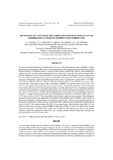Microsatellite analysis of the correlation between molecular and morphological traits in assorted maize inbred lines

View/
Date
2009Author
Karanja, J
Amugune, NO
Ininda J
Kimatu, JN
Danson, JW
Type
ArticleLanguage
enMetadata
Show full item recordAbstract
The success in identifying heterosis in hybrid maize (Zea mays L.) breeding depends on the availability of reliable genetic diversity among maize inbred lines. Conventional methods of breeding have been boosted by the availability and efficiency of molecular markers. Coupling simple sequence repeat (SSR) markers with morphological
markers provides thorough starting information for new inbred lines, especially from different genetic backgrounds. Furthermore, recent evidences that the environment can influence the epigenetic structure of the genome have necessitated morphological screening of crops during breeding programmes. This study used 28 agronomic
traits and 14 SSR markers which are distributed uniformly in ten (1-10) inbred lines, namely EM11-133, EM12-210, OSU23i, CML395, CML202, CML442, CML444, CML208, CML312 and CML204 from Kenya, International Centre for the Improvement of Maize and Wheat (CIMMYT), and another (OSU 23i) from USA. The aim was to investigate their morphological and genetic diversity, categorise the inbred lines into useful groups based on the molecular profiles and morphological traits, and lastly determine the level of phenotype-genotype correlation. The dissimilarity calculated using SSR markers had a mean morphological dissimilarity of 0.895403, an r value of -0.1421 and a p -0.9840. The dissimilarity between the molecular and morphological traits was 0.860465. Comparison between the molecular and morphological data had a dissimilarity matrix with an r -
0.2323 and a p value of 0.0120. This was probably due to intrinsic synteny in maize genome. The dendrograms generated with hierarchical Unweighted Pair Group Method with Arithmetic mean (UPGMA) cluster analysis of the Jaccard’s similarity coefficient matrices revealed four major clusters. The Co-ancestry distance showed six tied groups with the Kenya cluster showing some differentiation with Exact Tests for population differentiation with a p = 0.0513. The American inbred line (OSU 23i) segregated alone, while the Kenya lines (EM11-133 and
EM12-210) had close homology with the CIMMYT inbred lines (CMLs). A total of 2.0 alleles were detected among the inbred lines using bulk DNA samples and 14 SSR loci. Clustering analysis based on the genetic similarity coefficients separated the inbred lines into 4 groups with the American inbred line seeming to be genotypically more diverse from the others.
URI
http://www.ajol.info/index.php/acsj/article/view/54213http://erepository.uonbi.ac.ke:8080/xmlui/handle/123456789/33524
Citation
African Crop Science Journal. 17(3):133–144.Publisher
School of Biological Sciences
